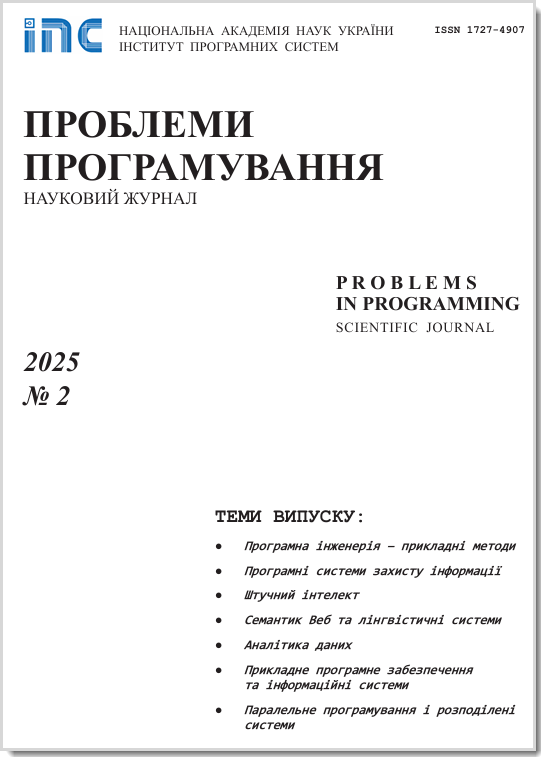Domain engineering approach of software requirements analysis
Abstract
Requirement analysis is one of the important processes in software development lifecycle management. In Agile approach requirements software models are the basic of generating other software development artifacts. Improving requirements approaches and techniques allows avoiding mistakes in other software development artifacts. Domain engineering fundamentals is the basic for “template oriented” approaches of software development artifacts designing. Reusing domain models and knowledge allows adding details in vertical “model to model” transformation operations, refine generated software development artifacts, organize systematic software reuse and perform many other activities. Paper proposes an approach of requirement analysis based on UML Use Case diagrams transformations into communication ones and the next refinements of them by means of information from domain models. The advantages of the proposed approach is the next: proposed transformation method involves ”many to many” transformation in order to save the semantic of initial model. Domain knowledge are used to complete communication diagram by means of adding details after transformation to them. In order to perform Use case to communication transformation graph representation of software models is chosen.
Problems in programming 2020; 2-3: 164-172
Keywords
Full Text:
PDFReferences
Hooper J.W., & Chester R.O. (1991). Software reuse: guidelines and methods. Springer Science & Business Media. CrossRef
Marshall J.J., & Downs R.R. (2008, July). Reuse readiness levels as a measure of software reusability. In IGARSS 2008-2008 IEEE International Geoscience and Remote Sensing Symposium (Vol. 3, pp. III-1414). IEEE. CrossRef
Smith M., & Sodhi J. (1994). Marching Towards a Software Reuse Future. ACM SIGAda Ada Letters, 14(6), 62-72. CrossRef
Vieira M., Madeira H., Cruz S., Costa M., & Cunha J.C. (2011, June). Integrating GQM and Data Warehousing for the Definition of Software Reuse Metrics. In 2011 IEEE 34th Software Engineering Workshop (P. 112-116). IEEE. CrossRef
Maga C., & Jazdi N. (2009, June). Concept of a domain repository for industrial automation. In Proceedings of the First International Workshop on Domain Engineering.
Komissarchik J., & Komissarchik E. (2008). U.S. Patent N 7,454,430. Washington, DC: U.S. Patent and Trademark Office.
Van der Meij L., Isaac A., & Zinn C. (2010, May). A web-based repository service for vocabularies and alignments in the cultural heritage domain. In Extended Semantic Web Conference (P. 394-409). Springer, Berlin, Heidelberg. CrossRef
Dwyer M.B., Hatcliff J., Robby R., Pasareanu C.S., & Visser W. (2007, May). Formal software analysis emerging trends in software model checking. In 2007 Future of Software Engineering (P. 120-136). IEEE Computer Society. CrossRef
Whalen M., Cofer D., Miller S., Krogh B.H., & Storm W. (2007, July). Integration of formal analysis into a model-based software development process. In International Workshop on Formal Methods for Industrial Critical Systems (P. 68-84). Springer, Berlin, Heidelberg.
https://doi.org/10.1007/978-3-540-79707-4_7">CrossRef
Qin W., Rajagopalan S., & Malik S. (2004, June). A formal concurrency model based architecture description language for synthesis of software development tools. In ACM SIGPLAN Notices (Vol. 39, N 7, P. 47-56). ACM. CrossRef
Fraser M.D., & Vaishnavi V.K. (1997). A formal specifications maturity model. Communications of the ACM, 40(12), 95-104. CrossRef
Satyananda T.K., Lee D., Kang S., & Hashmi S.I. (2007, August). Identifying traceability between feature model and software architecture in software product line using formal concept analysis. In 2007 International Conference on Computational Science and its Applications (ICCSA 2007) (P. 380-388). IEEE. CrossRef
Markopoulos P. (2013). A compositional model for the formal specification of user interface software (Doctoral dissertation).
Bjorner D. (2019). Domain analysis and description principles, techniques, and modelling languages. ACM Transactions on Software Engineering and Methodology (TOSEM), 28(2), 1-67. CrossRef
Cao L., Liu J., Wang Q., Jiang C., & Zhang L. (2019). An efficient structural uncertainty propagation method based on evidence domain analysis. Engineering Structures, 194, 26-35. CrossRef
Rabiser R., Schmid K., Eichelberger H., Vierhauser M., Guinea S., & Grünbacher P. (2019). A domain analysis of resource and
requirements monitoring: Towards a comprehensive model of the software monitoring domain. Information and Software Technology, 111, 86-109. CrossRef
D'silva V., Kroening D., & Weissenbacher G. (2008). A survey of automated techniques for formal software verification. IEEE Transactions on Computer-Aided Design of Integrated Circuits and Systems, 27(7), 1165-1178. CrossRef
Ouimet M., & Lundqvist K. (2007). Formal software verification: Model checking and theorem proving. Embedded Systems Laboratory Technical Report ESL-TIK-00214, Cambridge USA.
Ammann P., & Black P. E. (1999, October). Abstracting formal specifications to generate software tests via model checking. In Gateway to the New Millennium. 18th Digital Avionics Systems Conference. Proceedings (Cat. No. 99CH37033) (Vol. 2, P. 10-A). IEEE.
Bennion M., & Habli I. (2014, May). A candid industrial evaluation of formal software verification using model checking. In Companion Proceedings of the 36th International Conference on Software Engineering (P. 175-184). ACM. CrossRef
Jetley R., Iyer S.P., & Jones P. (2006). A formal methods approach to medical device review. Computer, 39(4), 61-67. CrossRef
Broy M., Krüger I.H., & Meisinger M. (2007). A formal model of services. ACM Transactions on Software Engineering and Methodology (TOSEM), 16(1), 5. CrossRef
Chebanyuk O. & Palahin O. (2019) Domain Analysis Approach. International journal "Informational Content and Processing". Volume 6, Number 2, 2019, 3-20.
Chebanyuk О. (2018) An Approach of Text to Model Transformation of Software Models. In Proceedings of the 13th International Conference on Evaluation of Novel Approaches to Software Engineering (ENASE 2018), 432-439 (видання індексується у SCOPUS) CrossRef
Chebanyuk E. (2014) An approach to class diagram designing. Proceedings of the 2st International Conference on Model-Driven Engineering and Software Development, 7-9 January 2014 y. Portugal, Lisbon. 579-583.
DOI: https://doi.org/10.15407/pp2020.02-03.164
Refbacks
- There are currently no refbacks.




